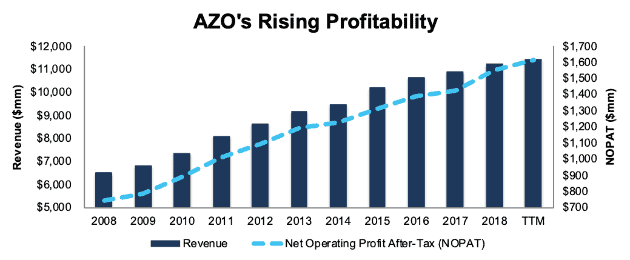Three new stocks make August’s Exec Comp Aligned with ROIC Model Portfolio, available to members as of August 16, 2019.
Recap from July’s Picks
Our Exec Comp Aligned with ROIC Model Portfolio (-5.8%) underperformed the S&P 500 (-5.6%) from July 12, 2019 through August 14, 2019. The best performing stock in the portfolio was up 14%. Overall, seven out of the 15 Exec Comp Aligned with ROIC Stocks outperformed the S&P.
The success of this Model Portfolio highlights the value of our Robo-Analyst technology[1], which scales our forensic accounting expertise (featured in Barron’s) across thousands of stocks.
This Model Portfolio only includes stocks that earn an Attractive or Very Attractive rating and align executive compensation with improving ROIC. We think this combination provides a uniquely well-screened list of long ideas because return on invested capital (ROIC) is the primary driver of shareholder value creation.[2]
New Stock Feature for August: AutoZone Inc. (AZO: $1,095/share)
AutoZone Inc. (AZO) is the featured stock in August’s Exec Comp Aligned with ROIC Model Portfolio.
From 2008 to 2018, AZO grew after-tax profit (NOPAT) by 8% compounded annually and revenue by 6% compounded annually. AZO’s trailing twelve months (TTM) NOPAT has grown by 4% over the prior TTM period. AZO’s ROIC has improved from 19% in 2008 to 25% TTM while the firm’s NOPAT margin increased from 11% to 14% over the same time.
Figure 1: AZO’s Revenue & NOPAT Since 2008

Sources: New Constructs, LLC and company filings
Executive Compensation Plan Helps Drive Shareholder Value Creation
AutoZone added return on invested capital to its executive compensation plan in 2002. In fiscal 2018, ROIC and EBIT were the two metrics used to calculate annual cash incentives. The total incentive award was determined based on the impact of EBIT and ROIC on AutoZone’s economic profit, rather than a portion of the award tied to EBIT and a portion tied to ROIC.
As noted in its proxy statement, “ROIC and EBIT have been determined by our Compensation Committee to be important factors in enhancing stockholder value.” Since adding ROIC to its executive compensation plan, AZO’s ROIC is up from 19% in 2002 to 25% TTM. Over that time, the stock has gained over 1,500%, while the S&P 500 is up ~160%.
AZO’s executive compensation plan lowers the risk of investing in this stock because we know executives’ interests are tied to shareholders’ interests.
AZO Remains Undervalued
At its current price of $1,096/share, AZO has a price-to-economic book value (PEBV) ratio of 1.0. This ratio means the market expects AZO’s NOPAT to never meaningfully grow from its current levels. This expectation seems pessimistic given that AZO has grown NOPAT by 10% compounded annually over the past two decades.
If AZO can maintain TTM NOPAT margins of 14% and grow NOPAT by just 4% compounded annually for the next decade, the stock is worth $1,538/share today – a 40% upside. See the math behind this dynamic DCF scenario.
Critical Details Found in Financial Filings by Our Robo-Analyst Technology
As investors focus more on fundamental research, research automation technology is needed to analyze all the critical financial details in financial filings. Below are specifics on the adjustments we make based on Robo-Analyst findings in AutoZone’s 2018 10-K:
Income Statement: we made $1 billion of adjustments, with a net effect of removing $215 million in non-operating expenses (2% of revenue). You can see all the adjustments made to AZO’s income statement here.
Balance Sheet: we made $2.3 billion of adjustments to calculate invested capital with a net increase of $2.3 billion. One of the largest adjustments was $1.7 billion in off-balance sheet operating leases. This adjustment represented 40% of reported net assets. You can see all the adjustments made to AZO’s balance sheet here.
Valuation: we made $7.8 billion of adjustments, all of which decreased shareholder value. Apart from total debt, which includes the operating leases noted above, the largest adjustment to shareholder value was $732 million in outstanding employee stock options. This adjustment represents 3% of AZO’s market cap. See all adjustments to AZO’s valuation here.
This article originally published on August 21, 2019.
Disclosure: David Trainer, Kyle Guske II, and Sam McBride receive no compensation to write about any specific stock, style, or theme.
Follow us on Twitter, Facebook, LinkedIn, and StockTwits for real-time alerts on all our research.
[1] Harvard Business School features the powerful impact of our research automation technology in the case New Constructs: Disrupting Fundamental Analysis with Robo-Analysts.
[2] This paper compares our analytics on a mega cap company to other major providers. The Appendix details exactly how we stack up.
